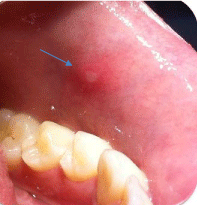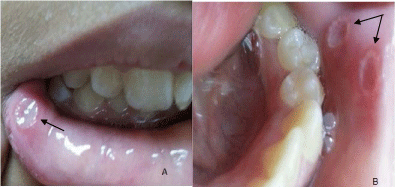Case Report
Low Serum Ferritin and Recurrent Aphthous Stomatitis in Young Females; A Case Series
Dar-Odeh NS*
College of Dentistry, Taibah University, Saudi Arabia
*Corresponding author: Najla Saeed Dar-Odeh, College of Dentistry, Taibah University, Al Madinah Al Monawara, Saudi Arabia, and Faculty of Dentistry, University of Jordan, Amman, Jordan
Published: 23 Jun, 2016
Cite this article as: Dar-Odeh NS. Low Serum Ferritin and
Recurrent Aphthous Stomatitis in Young
Females; A Case Series. Ann Clin Case
Rep. 2016; 1: 1014.
Abstract
Recurrent aphthous stomatitis is considered the most common type of recurrent oral ulcers that affects adversely the quality of life of patients. Its etiology is not well understood, however, nutritional and psychosocial factors have been suggested in a certain category of patients. The aim of this case series is to describe the hematological picture namely hemoglobin level, serum vitamin B12 and serum ferritin in six young female patients affected by recurrent aphthous stomatitis, and to report its association of low serum ferritin.
Keywords: Recurrent Aphthous Stomatitis (RAS); Ferritin
Introduction
Recurrent aphthous stomatitis (RAS) is considered the most common type of recurrent oral
ulcers. These ulcers present in three forms according to their clinical picture; the minor, major and
herpetiform ulcers. The most common form of these is the minor type which affects more than 85
% of RAS patients [1]. Clinically minor ulcers appear as shallow ulcers with a yellowish-whitish
floor and awell-defined red halo that is regular in shape [2]. Occurrence and recurrence of RAS
will eventually affect the quality of life of patients due to the associated oral soreness and burning
sensation jeopardizing oral functions like speaking, and mastication.
Approximately 20% of the general population is affected by RAS, but incidence varies from 5%
to 50% according to ethnicity and socioeconomic status [3].
Although etiology of RAS is not well-determined yet, nutritional and psychosocial factors have
been suggested in a certain category of patients [4]. A small percentage of RAS patients (5-10%)
show low serum levels of iron, folate, zinc, or vitamins B1, B2, B6 and B12 indicating that nutritional
deficiency is apparentlyan etiological factor for RAS [4,5].
This case series aims to report the laboratory findings namely hemoglobin level, serum vitamin
B12 and serum ferritin in seven RAS patients who attended the oral medicine clinic at Taibah
University Dental Hospital (TUDH) for treatment of their oral ulcers. It also aims to report the low
serum ferritin level that was observed in these patients.
Findings
Patients attended the oral medicine clinic complaining of recurrent oral ulcers. All patients
reported no medical illness except for the oral ulcers. They had minor ulcers that appeared exclusively
in the labial and/or buccal mucosa (Figure 1 and 2). History and clinical features were suggestive of
RAS. Topical treatment based on hyaluronic acid was prescribed to patients and they were referred
to the same laboratory to perform the following tests: complete blood count, serum ferritin and
serum vitamin B12. Patients' age range was 13-34 years (mean=20.4, SD=6.9). Only one patientwas
anemic (hemoglobin (Hb) = 9.2 g/dl), while the rest of patients had a normal Hb level (mean=13,
SD=1.74). Serum ferritin level ranged from 6-50.8 ng/ml (mean=26.1, SD=15.2), and serum vitamin
B12 ranged from 164-764 pg/ml (mean=461.4, SD=226.7). Patients who had low serum ferritin
were prescribed iron supplements, and they showed marked improvement in symptoms following
therapy.
Figure 1
Figure 1
Minor aphthous ulcer (arrow) affecting the labial mucosa of a non-anemic 22-year old woman with a serum ferritin level of 11.9 ng/ml.
Figure 2
Discussion
During the year 2015, the oral medicine clinic received approximately 90 new patients who had
various oral diseases ranging from local oral disease to oral manifestations of systemic disease. There
was seven RAS patients among them; six out of these were young females with low serum ferritin
level.
There are a number of factors that need to be approached when
addressing RAS in young female patients, namely; serum ferritin
levels, anemia, and stress initiated by school life. Iron deficiency is the
most common nutritional deficiency [6], and women have a higher
predisposition to developing iron deficiency [6], and to becoming
anemic [7]. Possible causes for iron deficiency in our patients may
include reduced intake and/or increased loss through menstruation.
In women, appearance of RAS may coincide with menses, and
studying-related stress may further explain the higher prevalence of
RAS in students [8,9].
Anemia in women is defined by the World Health Organization as
an Hb level that is below 12.0 g/dl [10], hence only one of the patients
had anemia (Hb level12.0 g/dl). Iron deficiency, on the other hand,
is best evaluated by measuring serum ferritin levels [11]. This may
explain why RAS is more prevalent among women.
Taking into consideration the fact that ferritin is an acute
phase protein that can be elevated in a variety of inflammatory and
infectious conditions, individuals may still have normal ferritin levels
in spite of being iron deficient (false negatives) [6].
Iron is critical for the growth and differentiation of all cells, and
its deficiency may lead to epithelial abnormality or atrophy [12,13].
Many studies have reported a highly significant reduction in the
total epithelial thickness, particularly the thickness of the maturation
compartment [14].
Iron deficiency without overt anemia can result in
neuropsychological effects and has been linked to delayed cognitive development in children and adolescents [15]. Interestingly, the
diagnosis of nutritional deficiency and anemia from oral mucosa
changes can be established in the absence of symptomatic anemia or
even in the pre-anemic stage [16].
Patients who are not anemic but have serum ferritin levels of
less than 15-30 ng/ml are diagnosed as having tissue iron deficiency
[17]. Six out of seven of our patients had serum ferritin levels of ≤
30 ng/ml indicating tissue iron deficiency. It had been suggested that
hematologic screening of RAS patients for anemia or deficiency of
iron, folate, and B vitamins is appropriate for patients with major RAS
or cases of minor RAS that worsen during adult life [1]. According to
the findings of this case series, another category of RAS patients that
require hematologic screening may also include young females.
Recommendations
Routine hematological screening for serum ferritin, folic acid
and vitamin B12 should be assessed in all patients with RAS to treat
any nutritional deficiency and to prevent more important related
systemic manifestations [18].
References
- Akintoye SO, Greenberg MS. Recurrent aphthous stomatitis. Dent Clin North Am 2014; 58: 281-297.
- Koybasi S, Parlak AH, Serin E, Yilmaz F, Serin D. Recurrent aphthous stomatitis: investigation of possible etiologic factors. Am J Otolaryngol. 2006; 27: 229-232.
- Rogers RS. Recurrent aphthous stomatitis: clinical characteristics and associated systemic disorders. Semin Cutan Med Surg. 1997; 16: 278-283.
- Dar-Odeh NS, Alsmadi OM, Bakri F, Abu-Hammour Z, Shehabi AA, AlOmiri MK, et al. Predicting recurrent aphthous ulceration using genetic algorithms-optimized neural networks. Adv Appl Bioinform Chem. 2010; 3: 7-13.
- Kozlak ST, Walsh SJ, Lalla RV. Reduced dietary intake of vitamin B12 and folate in patients with recurrent aphthous stomatitis. J Oral Pathol Med. 2010; 39: 420-423.
- Lu SY. Perception of iron deficiency from oral mucosa alterations that show a high prevalence of Candida infection. J Formos Med Assoc. 2016.
- Alquaiz AJ, Khoja TA, Alsharif A, Kazi A, Mohamed AG, Al Mane H, et al. Prevalence and correlates of anaemia in adolescents in Riyadh city, Kingdom of Saudi Arabia. Public Health Nutr. 2015; 18: 3192-3200.
- McCann AL, Bonci L. Maintaining women's oral health. Dent Clin North Am. 2001; 45: 571-601.
- Ship JA, Chavez EM, Doerr PA, Henson BS, Sarmadi M. Recurrent aphthous stomatitis. Quintessence Int. 2000; 31: 95-112.
- Cappellini MD, Motta I. Anemia in Clinical Practice-Definition and Classification: Does Hemoglobin Change With Aging?. Semin Hematol. 2015; 52: 261-269.
- Guyatt GH, Oxman AD, Ali M, Willan A, McIlroy W, Patterson C. Laboratory diagnosis of iron-deficiency anemia: an overview. J Gen Intern Med. 1992; 7: 145-153.
- Bermejo F, Garcia-Lopez S. A guide to diagnosis of iron deficiency and iron deficiency anemia in digestive diseases. World J Gastroenterol. 2009; 15: 4638-4643.
- Killip S, Bennett JM, Chambers MD. Iron deficiency anemia. Am Fam Physician. 2007; 75: 671-678.
- GWu YC, Wang YP, Chang JY, Cheng SJ, Chen HM, Sun A. Oral manifestations and blood profile in patients with iron deficiency anemia. J Formos Med Assoc. 2014; 113: 83-87.
- Grantham-McGregor S, Ani C. A review of studies on the effect of iron deficiency on cognitive development in children. J Nutr. 2001; 131: 649S-666S.
- Lu SY, Wu HC. Initial diagnosis of anemia from sore mouth and improved classification of anemias by MCV and RDW in 30 patients. Oral Surg Oral Med Oral Pathol Oral Radiol Endod. 2004; 98: 679-685.
- . Pasricha SR, Flecknoe-Brown SC, Allen KJ, Gibson PR, McMahon LP, Olynyk JK, et al. Diagnosis and management of iron deficiency anaemia: a clinical update. Med J Aust. 2010; 193: 525-532.
- . Compilato D, Carroccio A, Calvino F, Di Fede G, Campisi G. Haematological deficiencies in patients with recurrent aphthosis. J Eur Acad Dermatol Venereol. 2010; 24: 667-673.


